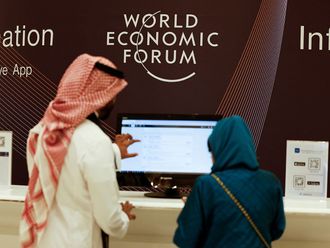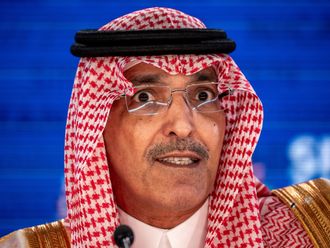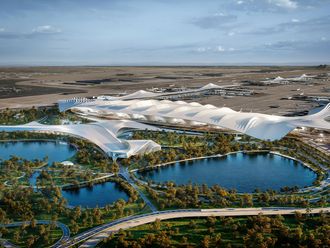
Dubai: From its beginnings in 1938 when it first struck oil with the aptly named “Well of Prosperity,” Saudi Arabia’s energy giant Aramco has delivered unimaginable riches to the kingdom.
It has since grown into the world’s largest and most profitable company, generating 10 per cent of global crude supplies and trillions of dollars in income.
Aramco has its origins in a 1933 concession agreement signed by the Saudi government with the Standard Oil Company of California. Drilling began in 1935 and the first oil began flowing three years later. It gained its current name from the subsidiary created to manage the agreement that was called the Arabia American Oil Company in the late 1940s.
In 1949, oil production hit a milestone 500,000 barrels per day and the following year Aramco built the 1,212km Trans-Arabian Pipeline to export Saudi oil to Europe across the Mediterranean Sea.
Production rose rapidly after the discovery of large offshore and onshore oilfields including Ghawar, the world’s largest with some 60 billion barrels of oil, and Safaniya, the biggest offshore field with 35 billion barrels.
In 1973, with prices spiking at the peak of the Arab oil embargo — imposed against the US over its policy on Israel — the Saudi government acquired 25 per cent of Aramco to increase its share to 60 per cent and become a majority stakeholder.
Seven years later, it was nationalised, and in 1988 it became the Saudi Arabian Oil Company, or Saudi Aramco.
From the 1990s, Aramco invested hundreds of billions of dollars in massive expansion projects, raising its oil output capacity to over 12 million barrels per day, alongside making bold international acquisitions and pursuing joint ventures.
In mid-September, Aramco maintained some 260 billion barrels in proven oil reserves, the second largest in the world after Venezuela, in addition to 300 trillion cubic feet of gas.
Based in Dhahran in the country’s east, the firm has key oil operations in the United States, China, India, South Korea and several European and Asian nations.
Aramco has also built a network of pipelines and refineries inside and outside the kingdom and expanded its presence in the petrochemicals industry. In the past few years and following the acquisition of petrochemicals giant SABIC, Aramco has become the largest integrated energy firm in the world. Opening its account books for the first time earlier this year, the company generated $356 billion in revenues in 2018.
HIGHLIGHTS
11 facts to know about Saudi Aramco’s intention to float
Saudi Arabia’s state oil company kicked off its initial public offering (IPO) on Sunday by announcing its intention to float on the Riyadh bourse. Here some highlights from the document:
1. Aramco said the final offer price, number of shares to be sold and percentage will be determined at the end of the book-building period. It will be offered to institutional and individual investors.
2. Saudi nationals will be eligible to receive one bonus share per 10 shares they hold for 180 days, up to a maximum 100 bonus shares.
3. Saudi Arabia’s CMA market authority has agreed to exempt non-resident institutional foreign investors that intend to subscribe from certain formalities to achieve qualified foreign investor status.
4. The board intends to declare aggregate ordinary cash dividends of at least $75 billion (Dh275 billion) in 2020. The government will forgo a quarterly dividend between 2020-2024 if needed in order to allow Aramco to pay a minimum cash dividend to other shareholders.
5. Aramco and the sovereign Public Investment Fund (PIF) agreed to amend payment terms so that 36 per cent of the purchase price will be paid in cash and 64 per cent will be paid as a seller loan on or before Sept 30, 2020.
6. The shares have not been registered under the United States Securities Act or the securities laws of any other jurisdiction other than Saudi Arabia.
7. In total 27 banks will be working on the IPO marketing. Nine banks are overseeing the listing as joint global coordinators: Citigroup, Credit Suisse, Goldman Sachs, HSBC, JPMorgan, Merrill Lynch, Morgan Stanley, NCB Capital and Samba Capital & Investment Management Company.
8. Five Saudi banks are working as domestic bookrunners, 11 as foreign bookrunners. Moelis, Lazard and Michael Klein are acting as special advisers.
9. The tax rate for Aramco’s downstream business will be reduced from the 50 to 85 per cent multi-tiered structure of income tax rate for domestic oil and hydrocarbon production companies to the general corporate tax rate of 20 per cent applicable to similar domestic downstream companies under Saudi’s income tax law.
10. This is on the condition that Aramco consolidates its downstream business under a separate, wholly-owned subsidiary before the end of 2024.
11. The period for which Aramco will not have to pay royalties on condensate production was extended for an additional 10 years after the current five-year period ending on January 1, 2023, and may be further extended for further 10-year periods subject to government approval.












